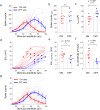Membrane depolarization mediates both the inhibition of neural activity and cell-type-differences in response to high-frequency stimulation
- PMID: 38890481
- PMCID: PMC11189419
- DOI: 10.1038/s42003-024-06359-3
Membrane depolarization mediates both the inhibition of neural activity and cell-type-differences in response to high-frequency stimulation
Abstract
Neuromodulation using high frequency (>1 kHz) electric stimulation (HFS) enables preferential activation or inhibition of individual neural types, offering the possibility of more effective treatments across a broad spectrum of neurological diseases. To improve effectiveness, it is important to better understand the mechanisms governing activation and inhibition with HFS so that selectivity can be optimized. In this study, we measure the membrane potential (Vm) and spiking responses of ON and OFF α-sustained retinal ganglion cells (RGCs) to a wide range of stimulus frequencies (100-2500 Hz) and amplitudes (10-100 µA). Our findings indicate that HFS induces shifts in Vm, with both the strength and polarity of the shifts dependent on the stimulus conditions. Spiking responses in each cell directly correlate with the shifts in Vm, where strong depolarization leads to spiking suppression. Comparisons between the two cell types reveal that ON cells are more depolarized by a given amplitude of HFS than OFF cells-this sensitivity difference enables the selective targeting. Computational modeling indicates that ion-channel dynamics largely account for the shifts in Vm, suggesting that a better understanding of the differences in ion-channel properties across cell types may improve the selectivity and ultimately, enhance HFS-based neurostimulation strategies.
© 2024. The Author(s).
Conflict of interest statement
The authors declare no competing interests.
Figures










Similar articles
-
Retinal ganglion cells: mechanisms underlying depolarization block and differential responses to high frequency electrical stimulation of ON and OFF cells.J Neural Eng. 2016 Feb;13(1):016017. doi: 10.1088/1741-2560/13/1/016017. Epub 2016 Jan 6. J Neural Eng. 2016. PMID: 26735572
-
Neural activity of functionally different retinal ganglion cells can be robustly modulated by high-rate electrical pulse trains.J Neural Eng. 2020 Aug 4;17(4):045013. doi: 10.1088/1741-2552/ab9a97. J Neural Eng. 2020. PMID: 32512555
-
Mediating Retinal Ganglion Cell Spike Rates Using High-Frequency Electrical Stimulation.Front Neurosci. 2019 Apr 30;13:413. doi: 10.3389/fnins.2019.00413. eCollection 2019. Front Neurosci. 2019. PMID: 31114476 Free PMC article.
-
Insights from Computational Modelling: Selective Stimulation of Retinal Ganglion Cells.2020 Aug 6. In: Makarov SN, Noetscher GM, Nummenmaa A, editors. Brain and Human Body Modeling 2020: Computational Human Models Presented at EMBC 2019 and the BRAIN Initiative® 2019 Meeting [Internet]. Cham (CH): Springer; 2021. 2020 Aug 6. In: Makarov SN, Noetscher GM, Nummenmaa A, editors. Brain and Human Body Modeling 2020: Computational Human Models Presented at EMBC 2019 and the BRAIN Initiative® 2019 Meeting [Internet]. Cham (CH): Springer; 2021. PMID: 32966012 Free Books & Documents. Review.
-
How voltage-gated ion channels alter the functional properties of ganglion and amacrine cell dendrites.Arch Ital Biol. 2002 Oct;140(4):347-59. Arch Ital Biol. 2002. PMID: 12228988 Review.
Cited by
-
Human Applications of Transcranial Temporal Interference Stimulation: A Systematic Review.medRxiv [Preprint]. 2025 Jun 23:2025.05.16.25327804. doi: 10.1101/2025.05.16.25327804. medRxiv. 2025. Update in: Brain Stimul. 2025 Aug 18:S1935-861X(25)00303-1. doi: 10.1016/j.brs.2025.08.010. PMID: 40463528 Free PMC article. Updated. Preprint.
References
Publication types
MeSH terms
Grants and funding
- VR170089/United States Department of Defense | United States Army | Army Medical Command | Congressionally Directed Medical Research Programs (CDMRP)
- P 35488/FWF_/Austrian Science Fund FWF/Austria
- FWF P35488/Austrian Science Fund (Fonds zur Förderung der Wissenschaftlichen Forschung)
- 2022M3E5E8017395/National Research Foundation of Korea (NRF)
- R01 NS110575/NS/NINDS NIH HHS/United States
LinkOut - more resources
Full Text Sources
Miscellaneous

